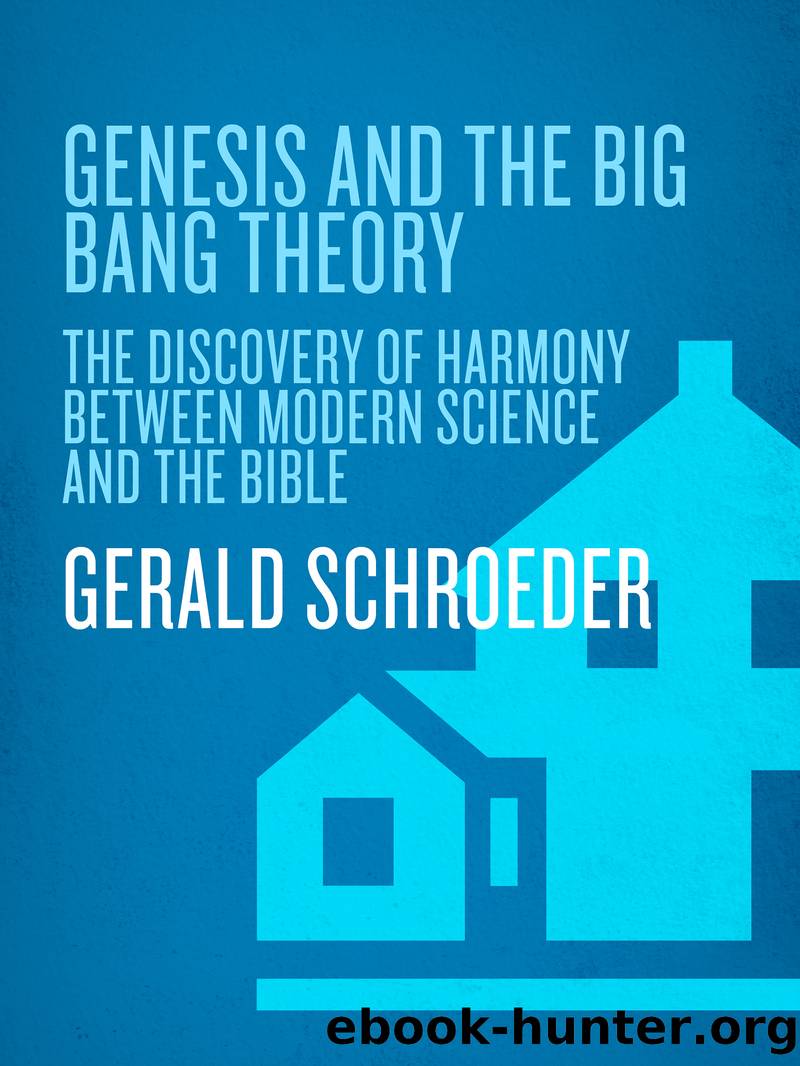Genesis and the Big Bang Theory by Gerald Schroeder

Author:Gerald Schroeder
Language: eng
Format: epub
ISBN: 978-0-307-80699-4
Publisher: Random House Publishing Group
Published: 2011-09-27T16:00:00+00:00
Notes
1. Nahmanides, Commentary on the Torah, Genesis 1:5.
2. Onkelos, Translation of the Torah, Genesis 1:3.
CHAPTER 7
Odds
The Chance of a Lifetime
Regarding the origin of life: Time performs the miracles. Time is in fact the hero of the plot.
—Nobel laureate George Wald
Random events cannot account for the origin of life, at least not in the time available.
—Harold Morowitz
When we study our cosmic roots, we are confronted with the possibility that the flow from inert matter to life might have occurred by random, unguided, chemical and physical reactions. We have learned in the preceding chapters that physical and chemical reactions follow natural laws, which were established with the creation of the universe. If we believe that this creation was the result of an act by God, then we might acknowledge a random development of life as being God-given through the Divine origin of the laws of nature. After all, it would have been these God-given laws of nature that had governed the interactions that led to life. God and not chance would still be the force of our existence.
With or without God, scientists and philosophers have espoused randomness in the flight of time toward the target of life. They have claimed that given enough time, a multitude of random combinations of matter will inevitably result in life.
In fact, at times it seems that the living and the inert are not so very different. Growth, for example, is certainly not the private bailiwick of life. A massive lump of salt in the Dead Sea starts as a single crystal that gradually adds more salt to its surface, removing it from the environment and organizing it to form the regular shape of the salt crystal. Electric charges on the crystal surface induce this reaction by attracting the appropriate atom to each given location. Granted, the salt crystal grows only in the sense that it reproduces an attached structure (the crystal) nearly identical with the initial spatial arrangement of atoms, but the simple form of life known as the virus does something quite similar. It takes from the host cell, which it has invaded, the cellular material needed to make replicas of itself.
Amino acids serve as the building blocks of protein. In living organisms, these organic molecules are synthesized within the cells of plants and microbes. In 1953, Stanley Miller reported the results of an experiment in which he synthesized amino acids by totally nonbiological reactions among simple inorganic compounds found throughout the universe.1 Miller showed that amino acids, the very basis of all life on Earth, could indeed be the product of random reactions. Their production did not depend on some supernatural guidance.
The machinery for organic cell reproduction is found in the genetic material referred to as DNA and RNA. We haven’t a clue as to its origins, but it appears that it works in a manner consistent with laws of physical chemistry. The DNA and RNA select, from the pool of organic and inorganic compounds within a cell, those molecules that fit into the genetic-code material.
Download
This site does not store any files on its server. We only index and link to content provided by other sites. Please contact the content providers to delete copyright contents if any and email us, we'll remove relevant links or contents immediately.
The Lost Art of Listening by Michael P. Nichols(7365)
Why I Am Not A Calvinist by Dr. Peter S. Ruckman(4078)
The Rosicrucians by Christopher McIntosh(3445)
Wicca: a guide for the solitary practitioner by Scott Cunningham(3109)
Signature in the Cell: DNA and the Evidence for Intelligent Design by Stephen C. Meyer(3002)
Real Sex by Lauren F. Winner(2939)
The Holy Spirit by Billy Graham(2840)
To Light a Sacred Flame by Silver RavenWolf(2744)
The End of Faith by Sam Harris(2665)
The Gnostic Gospels by Pagels Elaine(2445)
Waking Up by Sam Harris(2359)
Nine Parts of Desire by Geraldine Brooks(2303)
Jesus by Paul Johnson(2278)
Devil, The by Almond Philip C(2247)
The God delusion by Richard Dawkins(2226)
Heavens on Earth by Michael Shermer(2214)
Kundalini by Gopi Krishna(2119)
Chosen by God by R. C. Sproul(2098)
The Nature of Consciousness by Rupert Spira(2016)
